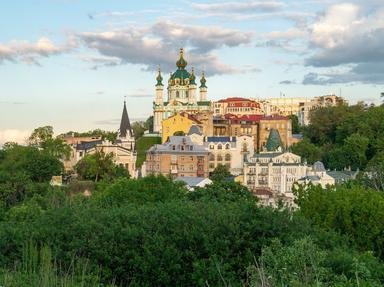Quiz Answer Key and Fun Facts
1. In 1917, the Ukrainian people raised the banner of national revolution, establishing a Provisional Government. Among other reforms, a division of Ukraine into Lands was carried out. In what Land was Mariupol placed?
2. One of Ukraine's enemies during her War of Independence was a short-lived Bolshevik republic which briefly claimed control over an area from Donetsk (including Mariupol) and a city located in modern-day Dnipropetrovsk Oblast. Which one?
3. Another important element of the Ukrainian War for Independence was the followers of Nestor Makhno. One of their battles, the Battle of Salhyr Yana Sala, happened in the vicinity of Mariupol. Who did Makhno's followers defeat there?
4. The decade of the 1930s in Mariupol was one of terror and political repressions. Apart from nationally conscious Ukrainians, another ethnic group of Mariupol was targeted by Stalin's agencies. Which one?
5. During the Second World War, the Ukrainian national liberation movement was influential in the area of Mariupol. What was the name of the Ukrainian patriot tasked with coordinating underground activities in Donetsk Oblast, including Mariupol, in 1941?
6. The Ukrainian nationalists in Mariupol and elsewhere, were actively pursuing a policy of education. Their reading societies were called "Prosvita" (Enlightenment). Who led the Prosvita in Mariupol until its destruction by the Nazis?
7. The leader of the Ukrainian nationalist underground in Mariupol was Mykola Stasyuk, who had been an agricultural scientist by profession. In 2023, his name was given to a street in one of the most populous Ukrainian cities. Which one?
8. After the Second World War, Mariupol returned to Soviet rule and had her name changed to Zhdanov. However, as the USSR was collapsing, Mariupol managed to reclaim her name. At what year did this happen?
9. The beginning of the Russo-Ukrainian War, in 2014, made Mariupol an epicenter of hostilities. Mariupol was initially captured by the so-called "Donetsk People's Republic", but was soon liberated. What is the date of its liberation?
10. In 2022, when the full-scale Russian invasion of Ukraine began, Mariupol was blockaded, bombed and bitterly fought over. In what building complex did the defenders make their last stand?
Source: Author
DeepHistory
This quiz was reviewed by FunTrivia editor
ponycargirl before going online.
Any errors found in FunTrivia content are routinely corrected through our feedback system.
